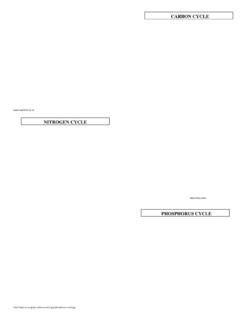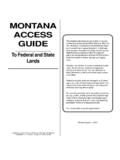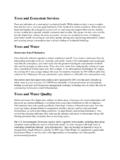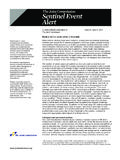Transcription of 2.Soil Erosion Causes & Effects - Envirothon
1 1 soil Erosion Causes and Effects : Introduction soil Erosion is one form of soil degradation along with soil compaction, low organic matter, loss of soil structure, poor internal drainage, salinization, and soil acidity problems. These other forms of soil degradation, serious in themselves, usually contribute to accelerated soil Erosion . soil Erosion is a naturally occurring process on all land. The agents of soil Erosion are water and wind, each contributing a significant amount of soil loss each year in Ontario. soil Erosion may be a slow process that continues relatively unnoticed, or it may occur at an alarming rate causing serious loss of topsoil. The loss of soil from farmland may be reflected in reduced crop production potential, lower surface water quality and damaged drainage networks. Erosion by Water The rate and magnitude of soil Erosion by water is controlled by the following factors: Rainfall Intensity and Runoff Both rainfall and runoff factors must be considered in assessing a water Erosion problem.
2 The impact of raindrops on the soil surface can break down soil aggregates and disperse the aggregate material. Lighter aggregate materials such as very fine sand, silt, clay and organic matter can be easily removed by the raindrop splash and runoff water; greater raindrop energy or runoff amounts might be required to move the larger sand and gravel particles. soil movement by rainfall (raindrop splash) is usually greatest and most noticeable during short-duration, high-intensity thunderstorms. Although the Erosion caused by long-lasting and less-intense storms is not as spectacular or noticeable as that produced during thunderstorms, the amount of soil loss can be significant, especially when compounded over time. Runoff can occur whenever there is excess water on a slope that cannot be absorbed into the soil or trapped on the surface. The amount of runoff can be increased if infiltration is reduced due to soil compaction, crusting or freezing.
3 Runoff from the agricultural land may be greatest during spring months when the soils are usually saturated, snow is melting and vegetative cover is minimal. soil Erodibility soil erodibility is an estimate of the ability of soils to resist Erosion , based on the physical characteristics of each soil . Generally, soils with faster infiltration rates, higher levels of organic matter and improved soil structure have a greater resistance to Erosion . Sand, sandy loam and 2 loam textured soils tend to be less erodible than silt, very fine sand, and certain clay textured soils. Tillage and cropping practices which lower soil organic matter levels, cause poor soil structure, and result of compacted contribute to increases in soil erodibility. Decreased infiltration and increased runoff can be a result of compacted subsurface soil layers. A decrease in infiltration can also be caused by a formation of a soil crust, which tends to "seal" the surface.
4 On some sites, a soil crust might decrease the amount of soil loss from sheet or rain splash Erosion , however, a corresponding increase in the amount of runoff water can contribute to greater rill Erosion problems. Past Erosion has an effect on a soils' erodibility for a number of reasons. Many exposed subsurface soils on eroded sites tend to be more erodible than the original soils were, because of their poorer structure and lower organic matter. The lower nutrient levels often associated with subsoils contribute to lower crop yields and generally poorer crop cover, which in turn provides less crop protection for the soil . Slope Gradient and Length Naturally the steeper the slope of a field, the greater the amount of soil loss from Erosion by water. soil Erosion by water also increases as the slope length increases due to the greater accumulation of runoff.
5 Consolidation of small fields into larger ones often results in longer slope lengths with increased Erosion potential, due to increased velocity of water which permits a greater degree of scouring (carrying capacity for sediment). Vegetation soil Erosion potential is increased if the soil has no or very little vegetative cover of plants and/or crop residues. Plant and residue cover protects the soil from raindrop impact and splash, tends to slow down the movement of surface runoff and allows excess surface water to infiltrate. The Erosion -reducing effectiveness of plant and/or residue covers depends on the type, extent and quantity of cover. Vegetation and residue combinations that completely cover the soil , and which intercept all falling raindrops at and close to the surface and the most efficient in controlling soil ( forests, permanent grasses).
6 Partially incorporated residues and residual roots are also important as these provide channels that allow surface water to move into the soil . The effectiveness of any crop, management system or protective cover also depends on how much protection is available at various periods during the year, relative to the amount of erosive rainfall that falls during these periods. In this respect, crops which provide a food, protective cover for a major portion of the year (for example, alfalfa or winter cover crops) can reduce Erosion much more than can crops which leave the soil bare for a longer period of time ( row crops) and particularly during periods of high erosive rainfall (spring and summer). However, most of the Erosion on annual row crop land can be reduced by leaving a residue cover greater than 30% after harvest and over the winter months, or by inter-seeding a forage crop ( red clover).
7 3 soil Erosion potential is affected by tillage operations, depending on the depth, direction and timing of plowing, the type of tillage equipment and the number of passes. Generally, the less the disturbance of vegetation or residue cover at or near the surface, the more effective the tillage practice is in reducing Erosion . Conservation Measures Certain conservation measures can reduce soil Erosion by both water and wind. Tillage and cropping practices, as well a land management practices, directly affect the overall soil Erosion problem and solutions on a farm. When crop rotations or changing tillage practices are not enough to control Erosion on a field, a combination of approaches or more extreme measures might be necessary. For example, contour plowing, strip cropping, or terracing may be considered. Effects Sheet and Rill Erosion Sheet Erosion is soil movement from raindrop splash resulting in the breakdown of soil surface structure and surface runoff; it occurs rather uniformly over the slope and may go unnoticed until most of the productive topsoil has been lost.
8 Rill Erosion results when surface runoff concentrates forming small yet well-defined channels. These channels are called rills when they are small enough to not interfere with field machinery operations. The same eroded channels are known as gullies when they become a nuisance factor in normal tillage. Surface runoff, causing gull formation or the enlarging of existing gullies, is usually the result of improper outlet design for local surface and subsurface drainage systems. The soil instability of fully banks, usually associated with seepage of ground water, leads to sloughing and slumping (caving-in) of bank slopes. Such failures usually occur during spring months when the soil water conditions are most conducive to the problem. Gully formations can be difficult to control if remedial measures are not designed and properly constructed. Control measures have to consider the cause of the increased flow of water across the landscape, and a multitude of conservation measures come into play.
9 Operations with farm machinery adjacent to gullies can be quite hazardous when cropping or attempting to reclaim lost land. Stream and Ditch Bank Erosion Poor construction, or inadequate maintenance, of surface drainage systems, uncontrolled livestock access, and cropping too close to both stream banks has led to bank Erosion problems. The direct damages from bank Erosion include: 1. The loss of productive farmland. 2. The undermining of structures such as bridges. 4 3. The washing out of lanes, roads and fence rows. Poorly constructed tile outlets may also contribute to stream and ditch bank Erosion . Some do not function properly because they have no rigid outlet pipe, or have outlet pipes that have been damaged by Erosion , machinery, inadequate or no splash pads, and bank cave-ins. On-Site Effects : The implications of soil Erosion extend beyond the removal of valuable topsoil.
10 Crop emergence, growth and yield are directly affected through the loss of natural nutrients and applied fertilizers with the soil . Seeds and plants can be disturbed or completely removed from the eroded site. Organic matter from the soil , residues and any applied manure, is relatively light-weight and can be readily transported off the field, particularly during spring thaw conditions. Pesticides may also be carried off the site with the eroded soil . soil quality, structure, stability and texture can be affected by the loss of soil . The breakdown of aggregates and the removal of smaller particles or entire layers of soil or organic matter can weaken the structure and even change the texture. Textural changes can in turn affect the water-holding capacity of the soil , making it more susceptible to extreme condition such a drought. Off-Site Effects : Off-site impacts of soil Erosion are not always as apparent as the on-site Effects .









